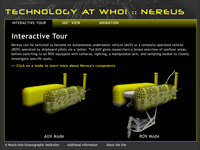Hybrid Remotely Operated Vehicle Nereus
Overview
HROV Nereus was lost at sea while exploring the Kermadec Trench at ~10,000 meters during a May 2014 research cruise.
» Official Statement» HADES Post: A Sad Day
» Remembrances & Condolences [ MORE ]
Hybrid Remotely Operated Vehicle Nereus: Exploring the oceans' deepest depths
Humans have been able to venture into just a tiny fraction of Earth’s deepest trenches at the bottom of the oceans—and then for only brief visits and at considerable expense. Expanding on these pioneering expeditions, scientists and engineers at Woods Hole Oceanographic Institution have built a new efficient, multi-purpose “hybrid” vehicle that can explore and operate in the crushing pressures of the greatest ocean depths.
On its first mission, the new vehicle, called Nereus (rhymes with “serious”), explored the deepest part of the ocean, Challenger Deep—a nearly 7-mile-deep trench east of the Marianas Islands in the western Pacific. The trench extends farther below the sea surface than Mount Everest reaches into the sky. In the future, Nereus could also be used under ice-capped polar waters.
Why is Nereus called a "hybrid" ROV?
Nereus, an unmanned vehicle, operates in two complementary modes. It can swim freely as an autonomous underwater vehicle (AUV) to survey large areas of the depths, map the seafloor, and give scientists a broad overview. When Nereus locates something interesting, the vehicle’s support team can bring the vehicle back on board the ship and transforms it into a remotely operated vehicle (ROV) tethered to the ship via a micro-thin, fiber-optic cable. Through this tether, Nereus can transmit high-quality, real-time video images and receive commands from skilled pilots on the ship to collect samples or conduct experiments with a manipulator arm.
How did Nereus get its name?
Nereus is a mythical Greek god with a fish tail and a man’s torso. The name was chosen in a nationwide contest open to junior high, high school, and college students.
High-tech components make Nereus smaller and lighter, enabling the vehicle to travel deeper for longer periods
- When operating in ROV mode, Nereus trails a hair-thin optical fiber, up to 25 miles in length, from a support ship. Like a high-speed Internet connection, the fiber can transmit high-quality video images to scientists on the ship. It also enables Nereus’s operators to have precise, interactive control of the vehicle.
- Nereus uses lightweight ceramic materials to provide buoyancy and shield electronics from intense seafloor pressure, replacing traditionally used (but heavier) metals and glass materials.
- To supply energy, Nereus carries rechargeable lithium-ion battery packs, similar to those powering laptop computers. Each pack contain more than 2,000 batteries.
Interactive Nereus Tour
 Interactive Nereus
Interactive NereusNereus is a new, one-of-a-kind vehicle designed and operated by Woods Hole Oceanographic Institution. It works in two modes: as a free-swimming, autonomous robot that surveys wide areas of the deep sea, or as a vehicle linked to a surface ship via a fiber-optic cable that transmits data and images up and sends commands down. Learn more about the vehicle in this interactive feature.
(Requires Adobe Flash Player)










 Facebook
Facebook Twitter
Twitter Instagram
Instagram Vimeo
Vimeo YouTube
YouTube LinkedIn
LinkedIn RSS Feeds
RSS Feeds







